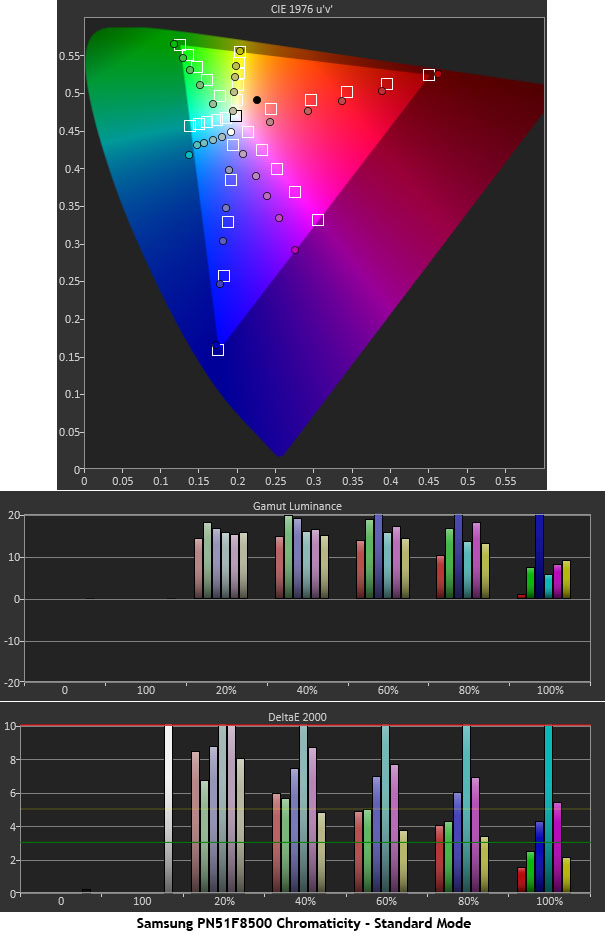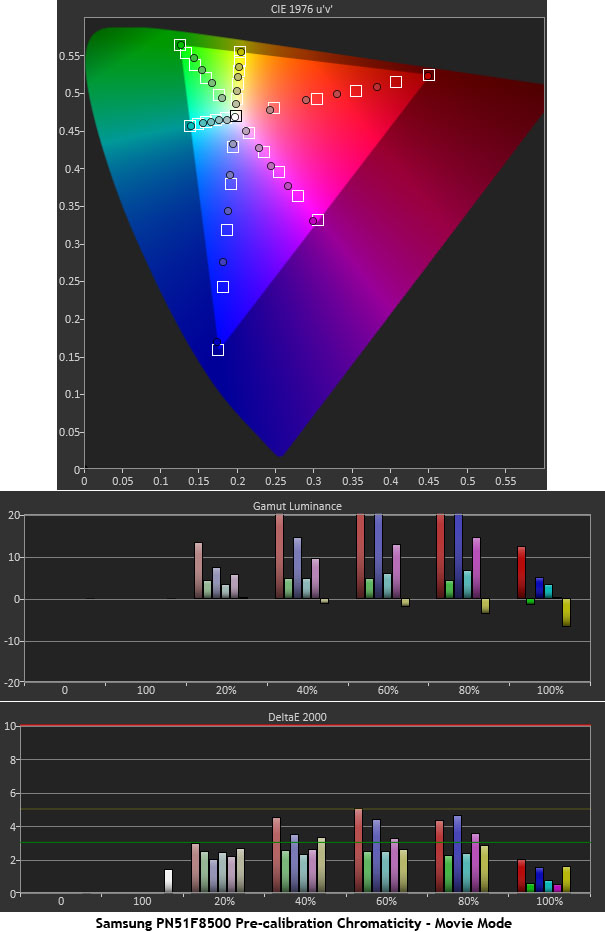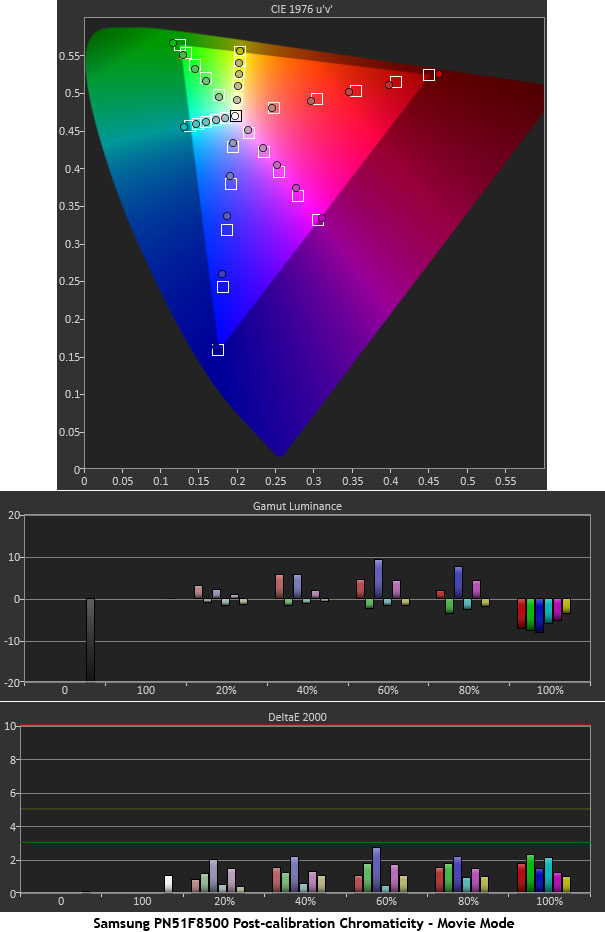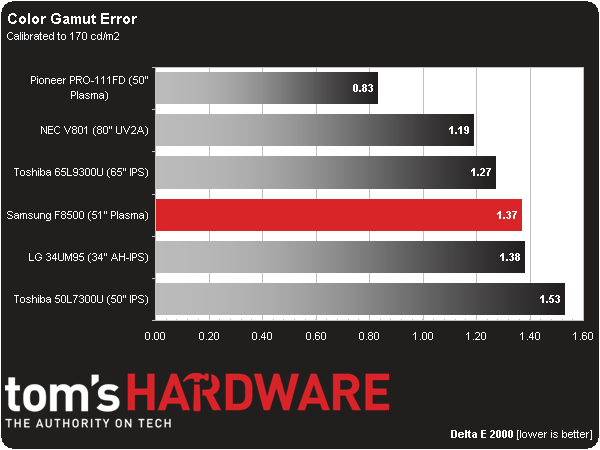Samsung PN51F8500 Review: A 51-Inch Plasma HDTV With SmartHub
Only two companies still make plasma TVs, so we’re excited to check out Samsung’s latest, the PN51F8500. It boasts 3D, SmartHub 2.0, and superb image quality. In the vast ocean of LCD televisions, it’s a compelling choice. Our lab results show you why.
Results: Color Gamut and Performance
Color gamut is measured using a saturation sweep that samples the six main colors (red, green, blue, cyan, magenta, and yellow) at five saturation levels (20, 40, 60, 80, and 100%), providing a realistic view of color accuracy.
We begin by showing you the Standard mode.
Since this is a pre-calibration result, there is room for improvement. The blue grayscale means that cyan, magenta, and red exhibit significant hue errors. Adjusting the color temp preset and/or the RGB controls helps there. Of equal concern are the saturation errors below 100 percent. You can see especially in the blue and red primaries that 20, 40, 60, and 80 percent fall well below their targets. The luminance chart shows that color brightness has been increased to compensate.
These are the results gathered from Movie mode prior to calibration. We already established that the white point is nearly perfect without adjustment. The hue errors from Standard mode are now corrected, and the saturation levels get closer to their targets. Overall color errors are only visible for red and blue.
Since we only changed the Blue Gain control during the grayscale calibration, we had to address the F8500’s CMS to see if we could make any other improvements. As it turned out, all we had to do was change the Color Space option from Auto to Custom. No other changes were necessary.
Blue and red still show a little under-saturation, but they are much better than before. The slightly-elevated luminance helps compensate. at least all of the errors fall below three, which takes the F8500’s color from good to excellent.
An average error of 1.37 Delta E puts the F8500 among our top group of displays, including monitors and HDTVs. The fact that this is achieved with only a few minor adjustments speaks highly of Samsung’s engineering and build quality.
Get Tom's Hardware's best news and in-depth reviews, straight to your inbox.
Current page: Results: Color Gamut and Performance
Prev Page Results: Grayscale Tracking and Gamma Response Next Page Results: Viewing Angles and Uniformity
Christian Eberle is a Contributing Editor for Tom's Hardware US. He's a veteran reviewer of A/V equipment, specializing in monitors. Christian began his obsession with tech when he built his first PC in 1991, a 286 running DOS 3.0 at a blazing 12MHz. In 2006, he undertook training from the Imaging Science Foundation in video calibration and testing and thus started a passion for precise imaging that persists to this day. He is also a professional musician with a degree from the New England Conservatory as a classical bassoonist which he used to good effect as a performer with the West Point Army Band from 1987 to 2013. He enjoys watching movies and listening to high-end audio in his custom-built home theater and can be seen riding trails near his home on a race-ready ICE VTX recumbent trike. Christian enjoys the endless summer in Florida where he lives with his wife and Chihuahua and plays with orchestras around the state.
-
Nuckles_56 People still buy plasma screened TV's? I thought they went out like the floppy disk...Reply -
Merry_Blind Damn Samsung TVs have so much lag... They have amazing picture quality, but aren't fast enough for proper gaming... sigh... bring on the OLED!!!Reply -
n3cw4rr10r Am I the only one who thinks this is overpriced? especially with 4k TVs getting close to this range (Vizio P series will be out soon for $1000).Reply -
n3cw4rr10r Am I the only one who thinks this is overpriced? especially with 4k TVs getting close to this range (Vizio P series will be out soon for $1000).Reply -
colson79 It is such a shame everyone bailed on Plasma TV's, I still have one and the picture quality blows away LCD in the home theater. Hopefully my Plasma will last until OLED is reasonable. It would suck having to go to LCD.Reply -
jkhoward I love the quality of Plasma TV's.. I truly hope they keep developing this technology.Reply -
DisplayJunkie @Nuckles_56 your level of ignorance is astronomical yet not uncommon; you are making a fool of yourself.Reply
@n3cw4rr10r It's not overpriced at all, but rather an outstanding value (though not as good a value as the sorely-missed Panasonic P50ST60). The image quality is tremendously better than any 4K TV, even with perfect 4K source content, even if they sold the 4K TVs for $1500 or less. The difference in contrast(dynamic range) is the most important, and it is huge. Side-by-side with the plasma, no one would pick any 4K LCD. -
nthreem It's worth noting that Samsung announced it will discontinue production of plasmas at the end of the year. Better pick one up soon!Reply
I got a Panasonic VT60 at the beginning of the year, just as stock was running dry. I'm still amazed by the picture quality. -
Nintendo Maniac 64 ReplyHopefully my Plasma will last until OLED is reasonable.
Actually OLED is arguably already there or getting there. Some people were able to pick up LG's 55" OLED TV for $2000 (not a typo) via in-store at Microcenter.
For a more universal price-point, it's newest revision is now going for $3500. -
photonboy ReplyDamn Samsung TVs have so much lag... They have amazing picture quality, but aren't fast enough for proper gaming... sigh... bring on the OLED!!!
Most HDTV's have a "GAMING MODE" option which disables video processing inside the HDTV for a particular HDMI input such as your game console might use.
Having said that, burn-in issues have never been completely solved so I wouldn't game on a Plasma anyway (seems an important thing to mention doesn't it?).



